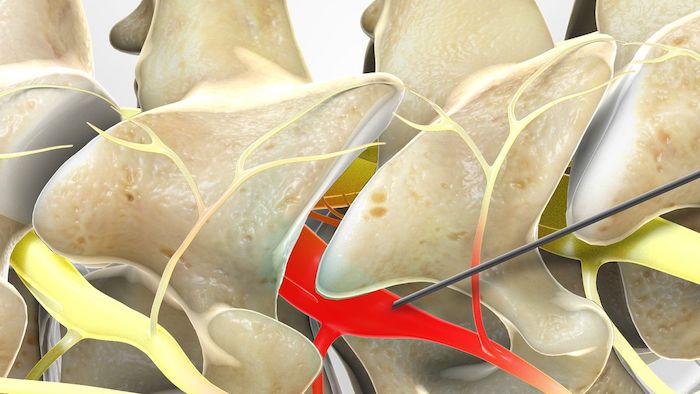
Minor Procedure Utilized for the Diagnosis and Prevention of Radiating Spinal Pain
Selected Nerve Root Injections (SNRI) are used to diagnose the source of pain and treat pain caused by spinal cord inflammation.
Selected Nerve Root Injection Facts & Information
Selected Nerve Root Injections (SNRI) deliver medication directly into an inflamed nerve root that exits the spinal cord. Spinal nerve roots are positioned along the length of the spinal column. They are responsible for sending and receiving sensory (feeling) and motor (motion) signals throughout the body. Nerve roots extend off the spinal cord and branch out in a complicated infrastructure of nerves.
Unfortunately, the proximity of the spinal nerve roots to the spinal column makes them susceptible to irritation, pressure, or pinching from a variety of spinal conditions such as spinal stenosis, facet syndrome, herniated disc, or sciatica, which is caused by pressure on the longest nerve running from the spine down both legs.
With any pain condition, catching the symptoms in the early phase will only help you during the healing process. With selected nerve root injections, patients who receive treatment tend to respond better than those who wait.
How Do Selected Nerve Root Injections Help?
During an SNRI, a local skin anesthetic is applied to numb the injection site, and a small needle is guided by fluoroscopy (x-ray) to the nerve root sleeve (a fatty substance that surrounds the nerve). A contrast dye is injected to confirm that the substance flows around the nerve root, and then the local anesthetic and corticosteroid anti-inflammatory medication is delivered.
An SNRI is used for both diagnosis and treatment. It helps determine if the nerve is irritated by “numbing” the nerve root of concern to produce temporary pain relief thereby confirming a particular nerve root as the source of pain or other symptoms such as tingling, numbness, or muscle weakness.
When the correct nerve root receives the corticosteroid, this longer-lasting medication soothes the irritated nerve root, promotes healing, and relieves pain.
How Long Does the Procedure Take?
Selected nerve root injections are safely performed on an outpatient basis. The procedure typically requires 20 minutes, including preparation time, and is followed by a short period of observed recovery time.
How Often Should this Procedure be Done?
Up to three injections may be given within a six-month time frame. Usually, injections are performed two to three weeks apart. A set of three injections is normal; however, you may gain considerable relief after the first or second injection. In that instance, further injections may not be necessary.
What are the Expected Results?
Selected nerve root injections (SNRIs) are a safe and effective treatment for pain that radiates from the spine. Immediately following the procedure, you should not drive for several hours because you may experience temporary numbness or weakness in an area such as an arm or leg.
It’s recommended that you take it easy the day of the procedure, but return to your usual activities the following day. Although initially, you might have some soreness at the injection site, the benefit from these injections will typically occur a few days following the procedure.
What if the Procedure is Ineffective for Me?
Every patient is unique and, in some cases, selected nerve root injections may not completely relieve the pain. In addition to SNRIs, a radiofrequency neurotomy procedure may be recommended to offer prolonged relief that you may not otherwise achieve. Radiofrequency (also referred to as RF) uses heat created by a special generator to desensitize specific nerves and interfere with their ability to transmit pain signals.
A radiofrequency procedure typically provides relief for 6 to 12 months, and for some up to two years and beyond!
Precision Pain Care and Rehabilitation has two convenient locations in Richmond Hill – Queens and New Hyde Park – Long Island. Call the Richmond Hill office at (718) 215-1888, or (516) 419-4480 for the Long Island office, to arrange an appointment with our Interventional Pain Management Specialist, Dr. Jeffrey Chacko.













